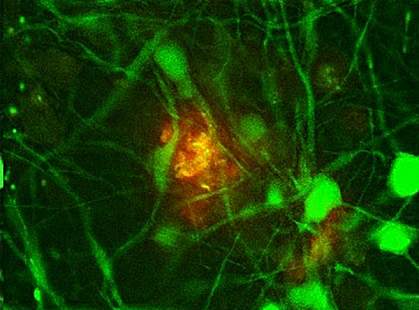You are here
November 3, 2014
Human Cells Model Alzheimer’s Disease
At a Glance
- Researchers designed a cell culture system that reproduces the development of Alzheimer’s disease.
- The system may aid in drug development and could potentially be adapted to study other neurodegenerative disorders.

Alzheimer’s disease is an irreversible, progressive brain disorder. It’s the most common cause of dementia among older people, affecting more than 5 million Americans. The condition, which isn’t a normal part of aging, slowly destroys memory and thinking skills.
Alzheimer’s disease has 2 key features in brain tissue: plaques and tangles. The plaques are abnormal clumps of toxic fragments of the protein beta-amyloid. These fragments are made from amyloid precursor protein and are found in the space between nerve cells. Tangles are abnormal masses of twisted protein threads inside cells made mainly of a modified form of the protein tau. This protein usually has a certain number of chemical tags, known as phosphate groups, attached. In Alzheimer’s disease, too many phosphate groups are attached. The tangles disrupt processes in cells, causing them to die.
To better understand the link between plaques and tangles, a team led by Drs. Rudolph Tanzi and Doo Yeon Kim at Massachusetts General Hospital used a cell culture system to develop a model of Alzheimer’s disease. The research was funded in part by NIH’s National Institute on Aging (NIA) and National Institute of Mental Health (NIMH). The study appeared online on October 12, 2014, in Nature.
The scientists grew human neural stem cells in a 3-D gel culture system. The cells were modified to produce high levels of 2 proteins—beta-amyloid precursor protein and presenilin—with mutations seen in inherited forms of Alzheimer’s disease. Over time, the neural cells secreted beta-amyloid, which formed plaques in the gel matrix. The cells also produced high levels of modified tau, which formed threads in the 3-D culture.
The team found that when they blocked beta-amyloid formation, plaques didn’t develop and levels of the modified tau protein decreased. This indicated that beta-amyloid accumulation contributes to the formation of tangles. When they added a compound that prevents extra phosphate groups from attaching to tau, it prevented the formation of tau tangles, even when amyloid plaques were present.
“In this new system that we call ’Alzheimer’s-in-a-dish,’ we’ve been able to show for the first time that amyloid deposition is sufficient to lead to tangles and subsequent cell death,” Tanzi says.
The cell culture system could potentially be used to screen drugs to prevent or treat Alzheimer’s disease. It might also inform development of cell culture models to study other neurodegenerative disorders.
—by Carol Torgan, Ph.D.
Related Links
- Study Points to Possible Blood Test For Memory Decline, Alzheimer’s
- New Genes Tied to Alzheimer’s Disease
- Dealing with Dementia
- Alzheimer’s Disease Education and Referral (ADEAR) Center
- Alzheimers.gov
References: A three-dimensional human neural cell culture model of Alzheimer’s disease. Choi SH, Kim YH, Hebisch M, Sliwinski C, Lee S, D’Avanzo C, Chen H, Hooli B, Asselin C, Muffat J, Klee JB, Zhang C, Wainger BJ, Peitz M, Kovacs DM, Woolf CJ, Wagner SL, Tanzi RE, Kim DY. Nature. 2014 Oct 12. doi: 10.1038/nature13800. [Epub ahead of print]. PMID: 25307057.
Funding: NIH’s National Institute on Aging (NIA) and National Institute of Mental Health (NIMH); and the Cure Alzheimer’s Fund.
